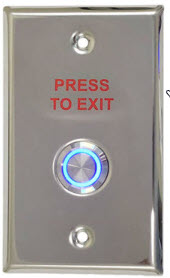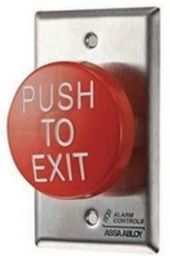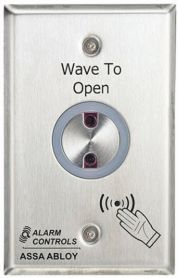All About Request To Exit (REX) In Your Access Control System
Request To Exit, or REX, is a simple concept and easy to incorporate in most access control environments. However, there are some applications where selecting and installing the correct REX Device can be challenging and deadly if not correct.
In its simplest application, REX is the action of unlocking a door as someone is leaving a building. This mostly only applies to doors secured with a maglock. Other door hardware has mechanical means to retract a latch or bolt when you press a bar or turn a handle. Maglocks do not inherently have a method of detecting if someone is entering or exiting a building. They hold the door as long as they have power. In high-security environments that is ideal. Card readers are located on both sides of the door. You need to present credentials to enter and leave.
If you are not going to restrict someone from leaving, you need to provide a method to unlock the door when someone tries to leave. If the locking mechanism allows free egress, then the access control system needs a device to signal that someone is leaving and not someone forcing the door open. A REX device is the method that provides that signal.
The most common Request To Exit devices





Scenario 1:
You have a door secured with a maglock. So long as there is power to the lock, that door is not going to open. A user approaches the door from the outside, they present their access control card to the card reader, and are granted access. The access control system removes power from the lock for a period of time, typically 5 to 15 seconds, and the user opens the door.
Now, that same user tries to leave the building. The user cannot open the door until a "Request To Exit" device senses their approach to the door and unlocks the door for them, or the user pushes a button that unlocks the door. The bar on a push bar can also have a switch inside that, when pressed, unlocks the door, and Infrared sensors can detect when you wave your hand in front of them. In each of these cases, a REX event occurred.
Scenario 2:
In this scenario, we are using a basic electric door strike. The door is secured from the outside but anyone can open the door from the inside to leave.
Door position sensors are often used in access control to monitor if a door is open or closed. These "Door Open" events can be logged or even displayed on a computer screen with a graphic map of the building(s). When a user scans their card the door unlocks and they open the door. In this case, the access control system expected the door to open. When that same user leaves the building, the door is opened from the inside but the access control system cannot distinguish between someone leaving or someone forcing the door open. The access control system will generate a "Door Forced Open" Alarm. This alarm can be a log-only event or trigger a siren or something in between.
A REX device can be used to inform the access control system that a user is opening the door from the inside. In this example, the REX event does not unlock the door it allows the door to be opened for a period of time without triggering an alarm event. If the door is held open too long a "Door Ajar" alarm can be configured.
A programming setting in all modern access control systems; REX input Unlock Door - YES / NO.
Warning: If you do not need the door to unlock, then say NO. Having a door unnecessarily unlock can create an Un-secure or Unsafe situation. There may also be excessive wear and tear on the locking mechanism.
Scenario 3
The same configuration as scenario 2, without the door sensor. A Door Intercom is added so people can be "Buzzed-In". Door intercoms have terminals exactly the same as REX devices. Intercoms are often connected to the REX inputs of an access control system and the REX is configured to unlock the door. In this scenario, no REX device was used but the REX inputs on the access control system were used for the "Buzz-In" ability.
If your access control plan uses the scenario 2 layout where you do NOT want the REX event to unlock the door, and you are using an Intercom as in scenario 3 where you DO want the REX inputs to unlock the door, you will need to work with your access control professional to develop an alternative means for one of those features.
Indirect vs Direct Control
There are two methods for incorporating a REX device into an access control system.
Indirect Control: Access control boards have a REX input. A two-wire terminal that when shorted or opened, unlocks the door. The REX device can be either a Motion Sensor, Push Button, or Push Bar Switch. Regardless of the REX device used, it has two wires that connect to the REX input on a Control Board. This is a control board event. The REX device has no direct effect on the power to the lock. It only provides information to the access control board that the door needs to unlock. If the control board fails, or the wiring between the REX device and the control board is damaged, then the door will not unlock when someone tries to leave. That is bad.
Direct Control: To increase safety, a REX device can be installed to have the door lock power routed through the device. Activate the motion sensor or push the button or press the bar and power is directly removed from the maglock or other fail-safe lock. When using maglocks it is required to have 2 REX devices for redundancy. It is a good practice to have at least 1 REX with Direct Control.
Active REX vs Mechanical (Passive) REX
Active REX: Motion-based REX, and some Push Button REX require power to operate. These are active devices. Without power, they will not provide the necessary signals to the access control board that the door needs to unlock or that someone is leaving and it's OK for the door to open. Which avoids "Door Forced Open" alarms. With some installations, the loss of the REX function is only an inconvenience that can be solved with a service call. In other situations, the loss of the REX function can mean a door does not open, even in a fire. There is more information on Fire and Life Safety in Part 2 of this article.
Mechanical REX: Most "Push to Exit" bars and Pneumatic buttons are mechanical, or passive devices. They do not require power to operate. You can use a simple momentary button as a REX device, but only if used in an Indirect Control method. Mechanical REX devices are most used as a method of Direct Control. This means they need to not only unlock the door, but also needs to hold the door unlocked for a period of time.
A Passive, Direct Control Push Bar will unlock the door as the user pushes to open the door. A button on a wall needs to unlock the door long enough for someone to actually open the door. If the button is 5 feet from the door you need at least 5 to 15 seconds. Pneumatic buttons have a mechanical timer. Once pushed you can adjust the switch to open for the time you require. Pneumatic buttons are highly reliable.
Life Safety
Access Control systems are great at restricting access to an area. However, in the event of a fire, you do not want to restrict access to 1st Responders. In fact, your local Fire Marshall will most likely require some method of disabling maglocks on main entrances.
Other door locks can usually be opened with a key, which is kept inside the Emergency KNOX box or similar key vault only accessible by the Fire Department. There are several methods you can use to automatically unlock doors in the event of a Fire.
The REX input on an access control board can be used to unlock a door in the same manner as the door intercom "Buzz-In" feature. A special Key Switch, programable Keypad, or similar Fire Department-only accessible method could connect to the REX input of the access control board.
However, the REX input will usually only unlock the door for 5-15 seconds (or whatever is programmed into the software). Many access control boards have multiple inputs which would allow the activation of those inputs to hold a door unlocked so long as the REX device or switch was active.
Both those options assume proper operation of the access control system. That is an indirect manner of unlocking a door, and can be subject to failure. For Life Safety scenarios you should plan on direct control of the door lock power.
Integration into the fire alarm system is the best method to unlock doors in case of fire. Door lock power can be routed through a relay controlled by the fire alarm control panel. The activation of this relay during a fire alarm is tested at least once a year as part of the Fire Alarm Annual Testing.
Another option is to use a Door Lock Power Supply with Fire Alarm Control Panel (FACP) inputs. A single fire alarm system relay is installed next to the Door Lock Power Supply. On activation of the fire alarm system relay, the door lock power supply is configured to unlock specific doors. This method is technically an indirect method because it relies on the proper function of the fire alarm panel and the FACP feature of the Door Lock Power Supply. However, UL Listed Fire Alarm Panels and Fire Rated Door Lock Power supplies are of the highest quality and tested at least once a year for proper operation. This makes their usage in this manner acceptable in all but the most stringent applications.